| Sixty Dome Mosque | |
|---|---|
| Native name Bengali: ষাট গম্বুজ মসজিদ | |
 | |
| Location | Bagerhat, Bangladesh |
| Coordinates | 22°40′28″N 89°44′31″E / 22.67444°N 89.74194°E |
| Area | 1,605 m2 (17,280 sq ft) |
| Built | 15th Century |
| Architect | Khan Jahan Ali |
| Architectural style(s) | Tughlaq |
| Type | Cultural |
| Criteria | iv |
| Designated | 1985 (9th session) |
| Reference no. | 321 |
| Region | Asia-Pacific |
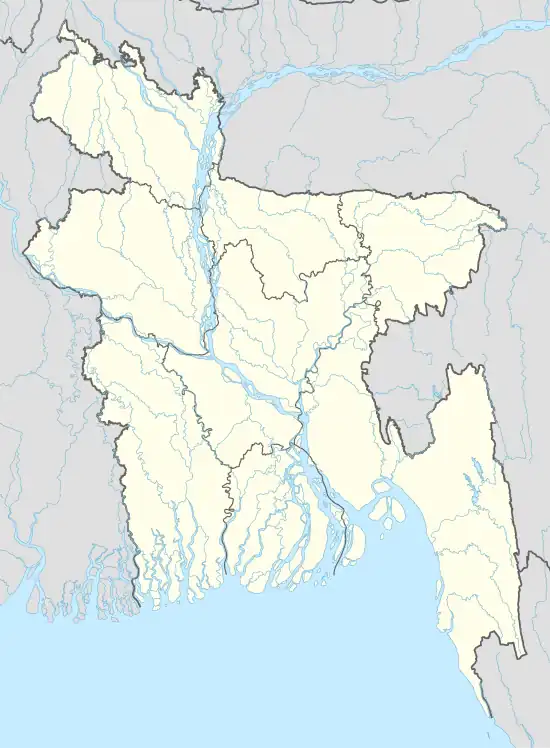 Location of Sixty Dome Mosque in Bangladesh | |
The Sixty Dome Mosque (Bengali: ষাট গম্বুজ মসজিদ Shaṭ Gombuj Moshjid; more commonly known as Shait Gambuj Mosque or Saith Gunbad Masjid), is a mosque in Bagerhat, Bangladesh. It is a part of the Mosque City of Bagerhat, a UNESCO World Heritage Site. It is the largest mosque in Bangladesh from the sultanate period (1352–1576). It was built during the Bengal Sultanate by Khan Jahan Ali, the governor of the Sundarbans. It has been described as "one of the most impressive Muslim monuments in the whole of South Asia."[1]
History
In the middle of the 15th century, a Muslim colony was founded in the mangrove forest of the Sundarbans, near the coast in the Bagerhat District by a saint-General, named Khan Jahan Ali. He preached in an affluent city during the reign of Sultan Nasiruddin Mahmud Shah, then known as 'Khalifatabad'.[2] Khan Jahan adorned this city with more than a dozen mosques, the ruins of which are focused around the most imposing and largest multi-domed mosques in Bangladesh, known as the Shait-Gumbad Masjid (160'×108').[2] The construction of the mosque began in 1442[2] and was completed in 1459. The mosque was used for prayers as well as a madrasha and assembly hall.
Location
It is situated in Bagerhat district, southern Bangladesh, within the Khulna Division.[1] It is about 5 kilometres (3 mi) from the main town of Bagerhat.[3] Bagerhat is nearly 320 km (200 mi) from Dhaka, the capital of Bangladesh.[4]
Style
The 'Sixty Dome' Mosque features unusually thick, tapered brick walls in the Tughlaq style and a hut-shaped roofline that anticipates later styles. Its oblong plan measures 148'6" x 101'4" externally and 123'3" x 76'2" internally.[5] There are 77 low domes arranged in seven rows of eleven, with an additional dome on each corner, bringing the total to 81 domes. There are four towers, two of four towers were used for the call to prayer (azaan). The interior is divided into many aisles and bays by slender columns, which culminate in numerous arches that support the roof.
The mosque has 77 squat domes with 7 four-sided pitched Bengali domes in the middle row. The vast prayer hall, although provided with 11 arched doorways on east and 7 each on north and south for ventilation and light, presents a dark and somber appearance inside. It is divided into 7 longitudinal aisles and 11 deep bays by a forest of 60 slender stone columns, from which springs rows of endless arches, supporting the domes. 1.8 m (6 ft) thick, slightly tapering walls and hollow and round, almost detached corner towers, resembling the bastions of fortress, each capped by small rounded cupolas, recall the Tughlaq architecture of Delhi. The western wall features eleven mihrabs on the interior where ten are blind and the central one is projected on the exterior.[5] The mosque represents wonderful archeological beauty which was the signature in the 15th century.
Sixty domes or sixty columns
The mosque is locally known in Bengali as the 'Shat Gombuj Masjid', which means Sixty Domed Mosque. However, there are 77 domes over the main hall and exactly 60 stone pillars.[3] It is possible that the mosque was originally referred to as the Sixty Pillared Mosque where Amud (شصت عمؤد ) meaning column in Arabic/Persian, later got corrupted to Gombuj (গম্বুজ) in Bengali, which means domes.
Gallery
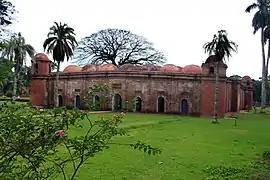 Side View
Side View Arch of the Mosque
Arch of the Mosque Exterior of the Mosque
Exterior of the Mosque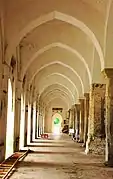 Inside of Mosque
Inside of Mosque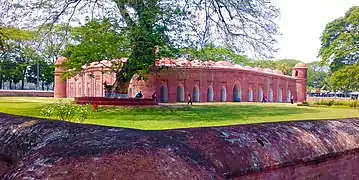 Southeastern View
Southeastern View Panoramic view of Sixty Dome Mosque
Panoramic view of Sixty Dome Mosque Ceiling of the Mosque
Ceiling of the Mosque.jpg.webp) Inside of the Mosque
Inside of the Mosque Arches of the Mosque
Arches of the Mosque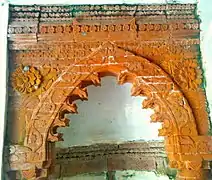 Arches of the Mosque
Arches of the Mosque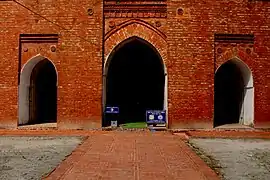 Exterior of the Mosque
Exterior of the Mosque Inside Pillars
Inside Pillars
See also
Notes
- 1 2 Bari, MA (2012). "Shatgumbad Mosque". In Islam, Sirajul; Jamal, Ahmed A. (eds.). Banglapedia: National Encyclopedia of Bangladesh (Second ed.). Asiatic Society of Bangladesh.
- 1 2 3 "Shat Gombuj Mosque – Bangladesh". Banglaview24.com. 2012-04-24. Retrieved 2013-08-28.
- 1 2 "Shat Gambuj Mosque: world Heritage site as a historical beautiful mosque". Travel-bangladesh.net. Retrieved 2013-08-28.
- ↑ "The Shat Gambuj Masjid (The Sixty Domes Mosque)". Rafiul alam. Retrieved 2012-04-14.
- 1 2 Reza, Mohammad Habib; Hossain, Md Shajjad (2017). Documentation of Islamic Heritage of Bangladesh. Dhaka: Brac University.
_002.jpg.webp)